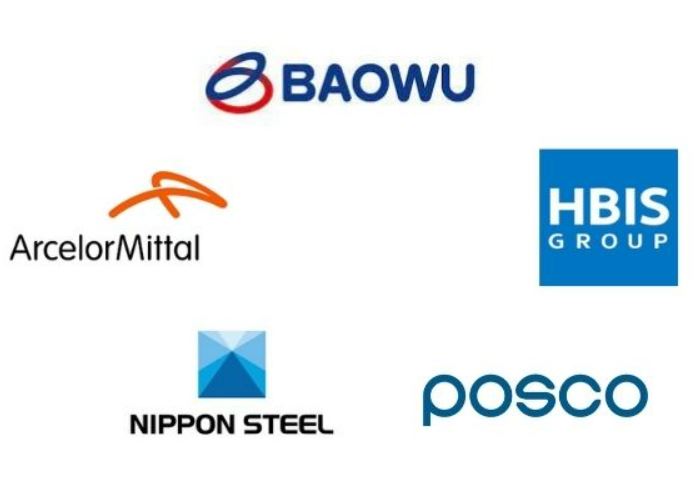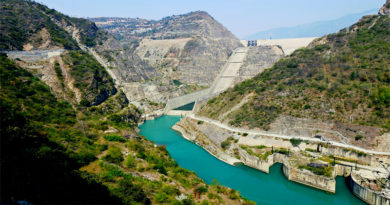The World’s Largest Steel Firms and Their Emissions Reduction Plans
Steel firms are looking at a range of solutions – replacing coal with green hydrogen, CCS/U, and direct iron electrolysis to reduce emissions. Country-wise, China is largest producer of steel (1064.8 million tons in 2020 - 56.7% of the total). India (100.3), Japan (83.2), the US (72.7), and Russia (71.6) follow

Of all the industrial sectors after fossil fuels, steel making is by far the largest, when it comes to carbon emissions. Steelmaking releases more than 3 billion metric tons of carbon dioxide each year, making it the industrial material with the biggest climate impact. With global steel production at almost 2 billion tonnes (or gigatons) in 2021, change couldn’t come fast enough here.
We look at 5 of the biggest steel firms and their measures toward net-zero emissions.
Country-wise, China is still in the lead with 1064.8 million tons of crude steel produced in 2020 (56.7% of the total). India (100.3) follows, with Japan (83.2), the United States (72.7), and Russia (71.6).
From wind turbines to electric vehicles, steel has been an integral enabler of the energy transition. However, steel is a major source of greenhouse gas (GHG) emissions as well. A major chunk of the steel production uses coal, and emits roughly two metric tons of CO2 per ton of steel. Apparently, the steel industry accounts for 7% of global GHG emissions from the energy system. For comparison, it is equivalent to global aviation, shipping and chemicals emissions combined.
That is one reason firms across China, Japan, the EU and the US, have finally set targets to reach net-zero status, as their host economies set ambitious goals . From replacing coal with green hydrogen, as a reducing agent, to carbon capture and storage or use (CCS/U), and eventually direct iron electrolysis, many pathways have been proposed.
Moreover, the opportunity for the steel firms to act “greener” cannot be better. In steel plants, major reinvestment and refurbishment take place only every 20 years or so at each production site. Fortunately, about half of Europe’s steel assets are up for reinvestment this decade. This provides a unique opportunity to give way to the transition by switching those production assets to zero-emission technologies.
The time is right for the steel industry to fulfil the goals of carbon neutrality set by their countries. We look at the top 5 steel firms with their net-zero commitments & opportunity for renewable energy.
#1 China Baowu Group
Headquarters – China, Asia
Steel Production Volume, 2020 – 115.29 million metric tons (MMT)
Net-zero target – 2050
Baowu is the largest steel firm in the world. In 2020, China’s Baowu crude steel output reached 115 million tons. It is distributed across 17 iron and steel bases. Baowu promised to reduce carbon emissions by 30 per cent to 1.3 tons of steel by 2035, based on 2020, and strive to be carbon neutral by 2050, a goal that will remain unchanged. The firm looks to peak in its carbon emissions by 2023.
Baowu has been working on hydrogen-rich blast furnace technology and pure hydrogen furnace technology. The Chinese steel-maker started construction of its first zero-carbon hydrogen furnace, with an Electric Arc Furnace (EAF) as a downstream steelmaking process, at Zhanjiang. It will be completed by 2023 and may reduce CO2 emissions to the tune of 500,000 metric tons annually. Furthermore, the firm has a green steel short process demonstration project in Bazhou, Xinjiang. The green electricity is generated by the photovoltaic power plant. In 2021, the factory had completed its planning, with construction scheduled to start in 2022.
The firm also has a carbon neutralization fund – a green low-carbon metallurgy innovation fund. The fund will spend 35 million yuan ($5.5 million) each year to research low-carbon metallurgy.
To boost the global steel industry’s low-carbon transformation, China Baowu initiated the Global Low-Carbon Metallurgical Innovation Alliance in Shanghai in November 2021.
#2 ArcelorMittal
Headquarters – Luxembourg, Europe
Steel Production Volume, 2020 – 78.46 MMT
Net-zero – 2050
ArcelorMittal S.A. is a multinational steel manufacturing corporation headquartered in Luxembourg City. ArcelorMittal is one of largest steel manufacturing firms in the world, with an annual crude steel production of 78.46 million metric tonnes in 2020.
Europe’s largest steel maker announced its target to reduce CO2 emissions by 30% by 2030, and its ambition to be carbon neutral by 2050.
ArcelorMittal signed an MoU on a billion-Euro joint investment with the Spanish government to build what it says will be the “world’s first full-scale zero carbon-emissions steel plant,” to go into production making around 1.6 million tons by 2025. ArcelorMittal Europe is investing in two routes to carbon neutrality, Smart Carbon and an innovative DRI-based route. This is in recognition of the need to act now to reduce CO2 emissions, in line with the EU’s Green Deal and the Paris Agreement.
The firm also boasts industrial-scale demonstration projects under construction for carbon-neutrality. The industrial-scale demonstration plants are under construction at the firm’s operations in Belgium (Carbalyst and Torero), France (3D and IGAR in Dunkirk). In Hamburg, Germany, the firm has plans for an industrial-scale project to use hydrogen instead of natural gas in the direct reduction of iron ore (DRI).
European Union announced EUR 75m loans for two supported projects (‘Steelanol’ and ‘Torero’), worth EUR 215m in total. These projects are set to reduce up to 350,000 tonnes of CO2 emissions per year in the first phase.
#3 HBIS Group
Headquarters – China, Asia
Steel Production Volume, 2020 – 43.76 MMT
Net-zero – 2050
Another Chinese firm, HBIS Group, is the second-largest steel producer in the country and third in the world. Its production in 2020 was 43.76 MMT. HBIS has made most ambitious goal to peak emissions by 2022.
HBIS announced its Low Carbon & Green Development Action Plan (The Plan) and setup its carbon peaking and carbon neutralization goals. Compared to the peak, by 2025, it will cut more than 10% of carbon emissions. Similarly, by 2030, it aims to reduce emissions 30%, and by 2050, it will achieve carbon neutralization.
Towards the green steel, HBIS has invested over RMB¥20.3billion covering 430 energy conservation and environmental protection projects. Apart from building the world’s cleanest steel mill, the firm claims the world’s first hydrogen energy development and pilot project. HBIS developed the world’s first Direct reduction of iron ore by hydrogen-rich gases pilot project in Zhang Jiakou, Hebei Province. The electricity used in electrolysis for producing iron will be produced from 100% renewable sources. HBIS aims to build a total annual capacity of 3.6 million tons of iron using hydrogen during the 14th Five-Year Plan period.
#4 Nippon Steel Corporation
Headquarters – Japan, Asia
Steel Production Volume, 2020 – 41.58 MMT
Net-Zero – 2050
Producing 41.58 MMT steel in 2020, Nippon Steel is Japan’s largest steel manufacturer. Nippon Steel has been making steel from mined iron and coal in blast furnaces for more than a century. Tagging along in the trend of pursuit of the green steel, Japanese steel-maker adopted “Nippon Steel Carbon Neutral Vision 2050 – A Challenge of Zero-Carbon Steel”. Consequently, the firm would target 30 per cent or more CO2 emissions reduction versus 2013 levels. The larger vision includes carbon neutrality by 2050.
Recently, the firm called out to state aid for carbon cuts to the tune of 2 trillion yen ($17.3 billion) in subsidies over three decades to meet net-zero carbon targets while competing the Chinese and other global rivals. Further, the company expects, it will cost as much as 5 trillion yen to build facilities enabling decarbonization by 2050.
The firm also aims to build 100% hydrogen-based plants, it wants to boost the use of hydrogen in existing furnaces. In addition, it also plans to make more metal via electric arc furnaces that remelt steel scrap.
#5 POSCO
Headquarters – South Korea, Asia
Steel Production Volume, 2020 – 40.58 MMT
Net-Zero – 2050
The East Asian nation, South Korea, boasts its largest steel manufacturer, POSCO, in the top 5 steel makers of the globe. In December 2020, POSCO declared target of ‘Net-zero Carbon’ by 2050.
Like other in the list, POSCO has set its long term and short-term targets for emissions. The firm aims to achieve a 10% reduction in 2030, 50% in 2040, and Net-zero carbon by 2050. Further, the firm looks to cut down emissions in stages – improving energy efficiency and replacing low-carbon fuel materials in the first stage, scrap utilization and CCUS technology in the second stage, and developing hydrogen reduction steel technology to prevent CO2 generation in the steel process.
In February 2022, the Green Steel Committee, of which POSCO is a part, was launched, while also signing ‘Net-zero carbon Joint Declaration 2050’. Apart from partnering on such initiatives, the firm is also making efforts towards renewable energy. The Adani group and POSCO have entered into a deal to explore business cooperation opportunities, including setting up a green, environment-friendly integrated steel plant at Mundra, Gujarat.
The fact that most firms have chosen to go with a 2050 target indicates the unique challenges of pushing them to do more. In a competitive market, for any one firm to seek higher achievements will be counter productive if it leads to a higher cost of steel. Thus, there is eventually a need for a global push to seek more ambitious targets across sectors like steel. It’s a complex challenge, but one that must be attempted.




